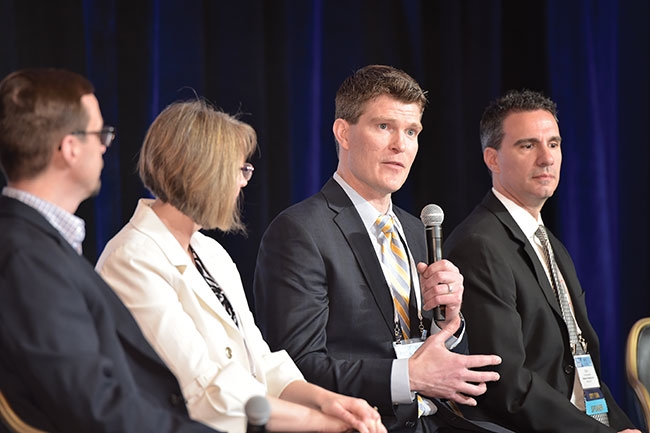
Features
Community
Event reports
The BEC sprint: Report from the NGA Building Envelope Conference
Report from the 2019 Building Envelope Conference in Las Vegas
May 28, 2019 By Rich Porayko
 Energy efficiency continued to be the hot topic at BEC in March. Attendees heard from experts that 2030 will come fast with aggressive targets for higher performance in many jurdisdictions around North America.
Energy efficiency continued to be the hot topic at BEC in March. Attendees heard from experts that 2030 will come fast with aggressive targets for higher performance in many jurdisdictions around North America. From the minute one lands in Las Vegas for BEC, you are on. Presented by the National Glass Association now with GANA, it is an intense whirlwind of networking, seminars, meetings, and events until you fly back out. This past March, over 550 attendees attended the biggest BEC in a decade.
The rumor mill was unusually quiet, however there was a lot of chatter that companies are having difficulties keeping up with volume. Of course, talk of labour shortages came from across the board.
The lead BEC panel discussion, Cutting-Edge Facades, moderated by NGA energy code consultant, Tom Culp, dove into thermally efficient fenestration systems – where they are now and where they are headed. The panel explored ways to improve U-factors and condensation resistance through edge-of-glass and framing technologies. Culp told attendees that starting June 3 in Vancouver, all commercial and residential buildings seven storeys and higher will have to meet Vancouver’s zero-emissions building plan. “They are trying to really aggressively push to get there in a 2030 time frame. That’s not so far away,” said Culp. “In the last 20 years we’ve seen a significant increase in the use of low-E glass. Market data is also showing a dramatic increase in thermally broken framing systems. The codes and markets are pushing that way. The trends are towards energy efficiency.”
“One of the key trends we’re seeing is the continued innovation of high-performance facades”, said Joe Erb, commercial sales specialist for Quanex Building Products. “There is a balanced approach on thermally broken framing materials, high performance glass and warm edge spacer technologies. All of this is driven to meet the more stringent energy codes that are coming out from ASHRAE.”
Erb explained how warm edge technology can contribute to achieve the challenges facing our exciting industry. “While the spacer may seem like a small component, it plays a critical and important role in overall performance in achieving thermal performance and condensation resistance.”
Technoform’s Helen Sanders explained that she uses the flow of a river as an analogy for flow of heat through a window. “If you want to block the flow of water in a river, it’s not much use putting a dam in the middle and forgetting about the edge. Water will flow freely around. It’s the same with a window. It’s no good making a great centre of glass and forgetting about the edge because the heat is just going to flow around the edge. It’s really important to think about the window more holistically so you are improving the thermal performance of the edges and the centre.”
“One statistic that blows me away is that commercial office buildings consume 40 per cent of the electricity generated in the United States annually,” said Cameron Scripture of Viracon. “That’s a lot of electricity. Lighting and air conditioning make up 50 per cent of the consumption of that energy. Things that we can impact the most with glass and glazing are the greatest users. Buildings are energy guzzlers. They are consuming energy at peak demand hours of the day. When electricity is most expensive is when these buildings are fully operating and consuming energy. We all have a great opportunity through our products and services to impact this.”
One of the ways we have of improving the solar heat gain coefficient is by using double- or triple-silver low-E coatings,” said Scripture. “Tinting that exterior substrate is also another measure to dramatically enhance SHGC. By adding a ceramic frit pattern with 40-60 per cent coverage onto the second surface of your glass, you can enhance your SGHC performance by 40 to 80 per cent. These measures are widely used throughout our industry because of their esthetics, ability to save energy and to provide fast payback.”
Moderated by Max Perilstein, the panel discussion “To DIY or Not: Advancing and Improving Glazing Project Management” highlighted the labour crunch facing construction trades. Brian Filipiak of Alliance Glazing told the audience that some of Alliances’ brightest people don’t even have a degree related to construction. “We have a biology major and others with degrees in other areas. It’s about the right fit for the culture.”
University of Nevada – Las Vegas’ Neil Opfer stunned attendees telling them that he is seeing about 10 job offers for every graduate. “It’s absolutely insane,” said Opfer. “The market in Las Vegas is so hot that you see contractors stealing people from other contractors.”
Author and motivational speaker, Mary Kelly, provided a fast paced, funny and informative keynote entitled “Change Management: Survive and Thrive in the New Economy.” “Our job as leaders is to see what’s coming. Our job is to forecast. Our whole purpose as leaders of our companies is to accurately predict what needs to happen next. Many of us look at past data but that doesn’t help at all moving forward.”
“Training your people is a huge issue,” said Kelly. After making a profit, Kelly explained that talent development and training is the number-one thing most CEOs have on their minds, and it’s where they are putting their dollars. “That’s it. You have to develop your people because that is going to move you forward.”
“Use the technology that is available to us,” said Kelly. “I often ask talent acquisition experts how many people do you have working from home? How many gig economy freelancers do you have? A lot say none and they are missing a huge, huge chunk. Many leaders say ‘I don’t know what they are doing all day if they are not here.’ I say, you don’t know what your own people are doing all day. You pay someone based on results, not for just showing up every day.”
FMI’s Cynthia Paul provided a sharp presentation and lively economic forecast in “Reading the Tea Leaves: Adjust, Adapt, Act.” Paul told attendees that Canada is recognized as the nicest country year-over-year. “They have their labour issues but they are going to continue to grow. Population growth in the U.S. is sitting at about 1.81 children for every woman of child bearing age. Canada is about 1.57 so they are growing through immigration and have grown more dramatically than the U.S. Oil prices are going up. Demand for housing is slowing. It’s a little bit different for mortgages. The Bank of Canada is much more conservative than the U.S. but they are going to continue to see some renovation work. The construction sector is being held hostage by talent shortages right now as the industry up there grows. One fifth of construction workers in Canada will retire in the next decade. That’s staggering. On average people leave the industry between 55 and 57. They are retiring at a rate of about 14 per cent and coming in at a rate of about 10 per cent. So anything around labour, talent, recruiting, development and technology will be the strategies at play.”
Paul explained that Canada has strong, diverse sectors and is going to continue to grow. “British Columbia is a very, very strong market led by Chinese investment. Saskatchewan has grown dramatically but is going to cool off a little bit. Canada has grown 1.7 million people in the last 18 months. Massive growth of people led through immigration.”
Print this page



Leave a Reply